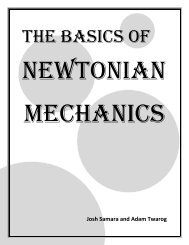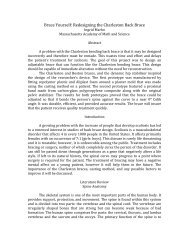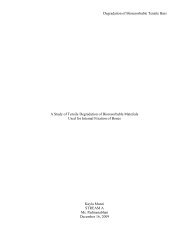Got Food? - the Scientia Review
Got Food? - the Scientia Review
Got Food? - the Scientia Review
Create successful ePaper yourself
Turn your PDF publications into a flip-book with our unique Google optimized e-Paper software.
An area of future research is bacteriocins, toxins produced by bacteria, for food preservation.<br />
Even though those formed by pathogenic bacteria are not suitable for processes dealing with foods,<br />
bacteriocins produced from lactic acid bacteria have been deemed safe. Scientists have already identified<br />
30 different bacteriocins, and <strong>the</strong>se may provide a food preservation process, which would be a natural<br />
method (Prokopov & Tanchev, 2007).<br />
Although preservation by heating technologies is well developed, o<strong>the</strong>r preservation technologies<br />
are still being developed and tested. One example is high pressure processing (HPP), but <strong>the</strong> aim of this<br />
method is not to replace heat techniques but advance a possible alternative. High hydrostatic pressure is<br />
an emerging technology that has <strong>the</strong> potential of improving <strong>the</strong> quality of processed foods and preserving<br />
modern food products. Meat and seafood are more frequently subjected to HPP, but plants have<br />
undergone HPP. The effects on shelf life and safety of specific food still need to be examined more<br />
closely (Heinz, 2010).<br />
The original discovery of successful HPP occurred over a century ago, but <strong>the</strong> process has been<br />
made more accessible and popular in <strong>the</strong> most recent decades. Three variables, temperature, pressure, and<br />
time exposed to pressure, alter <strong>the</strong> exact process of HPP. This differs from <strong>the</strong> more common two variable<br />
processes, and it allows for a more varied outcome using <strong>the</strong> same technique. After <strong>the</strong> food is subjected<br />
to pressure over 350 megapascals for a time period ranging from seconds to minutes, <strong>the</strong> microorganisms,<br />
viruses, and spores in <strong>the</strong> food are inactive. However, <strong>the</strong> vitamins, flavors, and color are virtually<br />
unaffected (Heinz, 2010).<br />
High pressure processing, a possible technology<br />
used to complete high pressure processing.<br />
Growing food, which is less susceptible to spoilage than o<strong>the</strong>r foods, is ano<strong>the</strong>r focus of food<br />
scientists. Techniques for growing foods using LED lights in urban settings have recently shown to be<br />
successful. These plants have been shown to have a higher sustainability than o<strong>the</strong>r foods grown using<br />
traditional methods (Wogan, 2011).<br />
113
















